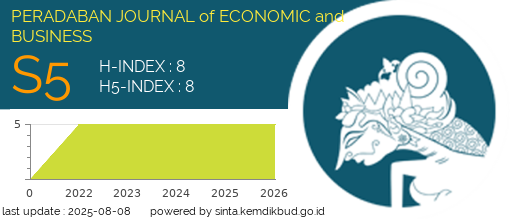Pengaruh Debt to Equity Ratio dan Arus Kas Operasi terhadap Kinerja Keuangan Perusahaan Transportasi dan Logistik
DOI:
https://doi.org/10.59001/pjeb.v4i2.460Keywords:
arus kas operasi, debt to equity ratio, kinerja keuangan, sektor transportasi dan logistikAbstract
The transportation and logistics sector plays a strategic role in supporting the distribution of goods and services as well as sustaining national economic growth. This study aims to examine the effect of the debt to equity ratio (DER) and operating cash flow on the financial performance of transportation and logistics companies listed on the Indonesia Stock Exchange (IDX) during the 2013–2024 period. Data were obtained from annual financial reports selected using a purposive sampling technique and analyzed with multiple linear regression. The results reveal that DER has no significant effect on financial performance, while operating cash flow shows a significant positive effect. These findings provide theoretical implications by strengthening the financial accounting literature, emphasizing that operating cash flow is a more relevant indicator of financial performance than capital structure ratios such as DER, particularly in the transportation and logistics sector. From a practical perspective, the results suggest that company management should prioritize strategies to optimize operating cash flow, while investors are encouraged to use operating cash flow as a key indicator when assessing the financial health of companies in this sector.
Sektor transportasi dan logistik memiliki peran strategis dalam mendukung distribusi barang dan jasa serta menopang pertumbuhan ekonomi nasional. Penelitian ini bertujuan menganalisis pengaruh debt to equity ratio (DER) dan arus kas operasi terhadap kinerja keuangan perusahaan transportasi dan logistik yang terdaftar di Bursa Efek Indonesia (BEI) periode 2013–2024. Data diperoleh melalui laporan keuangan tahunan perusahaan yang dipilih dengan teknik purposive sampling dan dianalisis menggunakan regresi linier berganda. Hasil penelitian menunjukkan bahwa DER tidak berpengaruh signifikan terhadap kinerja keuangan, sedangkan arus kas operasi berpengaruh signifikan. Temuan ini memiliki implikasi teoretis dengan memperkuat literatur akuntansi keuangan mengenai dominasi arus kas operasi dibandingkan rasio struktur modal dalam menjelaskan kinerja keuangan. Dari sisi praktis, hasil penelitian ini memberikan masukan bagi manajemen perusahaan untuk memprioritaskan strategi peningkatan arus kas operasi, serta bagi investor dalam menilai kesehatan finansial perusahaan di sektor transportasi dan logistik.
References
Agustina, R. C., & Santosa, A. (2019). Pengaruh DAR, DER dan tata kelola perusahaan terhadap kinerja keuangan perusahaan farmasi [The effect of DAR, DER and corporate governance on pharmaceutical companies' financial performance]. Capital: Jurnal Ekonomi dan Manajemen, 3(1), 16. https://doi.org/10.25273/capital.v3i1.5061
Ahmad, F. F. (2020). Pengaruh arus kas operasi dan fixed assets turnover terhadap return on assets (ROA) [The effect of operating cash flow and fixed assets turnover on ROA]. Jurnal Ilmu Manajemen Retail (JIMAT), 1(2). https://doi.org/10.37150/jimat.v1i2.980
Alfiani, N. Y., & Hasanuh, N. (2024). Pengaruh DER dan DAR terhadap ROA pada perusahaan farmasi yang terdaftar di BEI tahun 2012-2020 [The effect of DER and DAR on ROA in pharmaceutical companies listed on IDX 2012-2020]. Jurnal Pendidikan Tambusai, 8(1), 8326–8332. https://doi.org/10.31004/jptam.v8i1.13631
Angelia, B., & Merina, C. I. (2023). Pengaruh arus kas operasi, arus kas investasi, dan arus kas pendanaan terhadap profitabilitas pada perusahaan consumer cyclicals yang terdaftar di Bursa Efek Indonesia (BEI) [The effect of operating, investing and financing cash flows on profitability]. Jurnal Ilmiah Manajemen, Ekonomi, & Akuntansi (MEA), 7(3), 989–1002. https://doi.org/10.31955/mea.v7i3.3440
Arsyad, A. R. I. A., & Ramli, A. (2022). Pengaruh arus kas terhadap kinerja keuangan pada perusahaan sub sektor telekomunikasi [The effect of cash flow on financial performance in telecommunications companies]. Jurnal Pendidikan dan Konseling, 4(5), 1349–1358. https://doi.org/10.31004/jpdk.v4i5.7055
Benget, J. L., Sitanggang, T. N., & Mentalita, H. (2022). Faktor-faktor yang mempengaruhi kinerja keuangan perusahaan yang terdaftar dalam indeks IDX Quality30 [Factors affecting financial performance of companies in IDX Quality30 index]. Jurnal Ekonomi dan Bisnis (EK&BI), 5(1), 151–156. https://doi.org/10.37600/ekbi.v5i1.493
Brigham, E. F., & Houston, J. F. (2011). Dasar-dasar manajemen keuangan: Essentials of financial management (11th ed.). Salemba Empat.
Fitriyanti, L. (2024). Pengaruh kinerja keuangan pada perusahaan manufaktur yang terdaftar di Bursa Efek Indonesia [The effect of financial performance in manufacturing companies]. Jurnal Akuntansi FE-UB, 17(1), 1–10. https://ejournal.borobudur.ac.id/index.php/akuntansi/article/view/1-10
Kurniawati, C. R. (2022). Pengaruh current ratio, total asset turnover, dan debt to equity ratio terhadap return on asset [The effect of current ratio, total asset turnover and debt to equity ratio on ROA]. Jurnal Cendekia Keuangan, 1(2), 101–112. https://doi.org/10.32503/jck.v1i2.2832
Kusumawati, E., & Widaryanti, W. (2022). Analisis pengaruh debt to equity ratio, current ratio, dan total aset turnover terhadap kinerja keuangan [Analysis of DER, current ratio and total asset turnover on financial performance]. Jurnal Ilmiah Fokus Ekonomi, Manajemen, Bisnis & Akuntansi (EMBA), 1(2), 227–234. https://doi.org/10.34152/emba.v1i2.513
Lisdayani, Mandaraira, F., Devilishanti, T., Mardaleta, & Manan, A. A. (2025). Pengaruh debt to equity ratio dan debt to asset ratio terhadap return on equity pada sektor perusahaan asuransi [The effect of DER and DAR on ROE in insurance companies]. Jurnal Manuhara: Pusat Penelitian Ilmu Manajemen dan Bisnis, 3(1), 199–217. https://doi.org/10.61132/manuhara.v3i1.1520
Myers, S. C., & Majluf, N. S. (1984). Corporate financing and investment decisions when firms have information that investors do not have. Journal of Financial Economics, 13(2), 187–221. https://doi.org/10.1016/0304-405X(84)90023-0
Napitupulu, F. (2020). Pengaruh arus kas operasi, penjualan dan likuiditas terhadap profitabilitas [The effect of operating cash flow, sales and liquidity on profitability]. Journal of Business and Economics Research (JBE), 1(2), 70–79. https://doi.org/10.47065/jbe.v1i2.184
Puspita, A., Nikhal, Z. Z., & Toriq, A. (2025). Analisis pengelolaan arus kas dan dampaknya terhadap kinerja keuangan [Cash flow management analysis and its impact on financial performance]. Journal of Humanities Education Management Accounting and Transportation, 2(1), 557–569. https://doi.org/10.57235/hemat.v2i1.5152
Ramayanti, S., Hinggo, H. T., & Sulistyandari. (2023). Pengaruh likuiditas, debt equity ratio dan total assets turn over terhadap kinerja keuangan [The effect of liquidity, DER and total assets turnover on financial performance]. Prosiding Seminar Nasional Ekonomi, Bisnis & Akuntansi, 3, 1167–1176. https://ejurnal.umri.ac.id/index.php/sneba/article/view/5774
Riyanto, A., Raspati, G., Rahayu, Y., & Sopian, Y. (2021). Implikasi arus kas aktivitas operasi terhadap kinerja keuangan [Implications of operating cash flow on financial performance]. Moneter: Jurnal Akuntansi dan Keuangan, 8(1), 79–84. https://doi.org/10.31294/moneter.v8i1.10065
Sari, N., & Wi, P. (2022). Pengaruh leverage, ukuran perusahaan, struktur modal, dan profitabilitas terhadap kinerja keuangan [The effect of leverage, firm size, capital structure and profitability on financial performance]. Global Accounting, 1(3). https://jurnal.ubd.ac.id/index.php/ga
Badan Pusat Statistik. (2024). Distribusi dan laju pertumbuhan ekonomi Indonesia triwulan IV 2021–2023 [Distribution and growth rate of Indonesian economy Q4 2021–2023]. https://www.bps.go.id/
Sugiharto, M. P. N. B., & Amanah, L. (2020). Pengaruh likuiditas, profitabilitas dan leverage terhadap kebijakan dividen [The effect of liquidity, profitability and leverage on dividend policy]. Jurnal Ilmu dan Riset Akuntansi, 9(9). https://jurnalmahasiswa.stiesia.ac.id/index.php/jira/article/view/3634
Sukandi, S., Hermawan, N., & Alfio, A. (2024). Pengaruh debt to equity ratio (DER) terhadap return on assets (ROA) [The effect of DER on ROA]. Journal of Social and Economics Research, 6(1), 547–555. https://idm.or.id/JSER/index.php/JSER
Wahyu, N. (2013). Pengaruh arus kas operasi dan modal kerja terhadap profitabilitas [The effect of operating cash flow and working capital on profitability]. Konferensi Nasional Ilmu Sosial dan Teknologi (KNIST), 1(1), 67–73.
Yuliani, E. (2021). Pengaruh struktur modal, likuiditas dan pertumbuhan penjualan terhadap kinerja keuangan [The effect of capital structure, liquidity and sales growth on financial performance]. Jurnal Ilmu Manajemen, 10(2), 111–122. https://doi.org/10.32502/jimn.v10i2.3108
Yunira, H. (2022). Pengaruh debt tax shield dan efektif tax rate terhadap struktur modal [The effect of debt tax shield and effective tax rate on capital structure]. Owner: Riset & Jurnal Akuntansi, 6(2), 1144–1156. https://doi.org/10.33395/owner.v6i2.534
Downloads
Published
How to Cite
Issue
Section
License
Copyright (c) 2025 Lutfiah Aribah, Sri Wahyuni Jamal, Muhammad Iqbal Pribadi

This work is licensed under a Creative Commons Attribution-NonCommercial-ShareAlike 4.0 International License.





